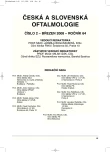Applying the DNA Diagnostics in Patients with Superficial Keratitis of Viral Origin
Authors:
Z. Hlinomazová 1; O. Šerý 2; M. Horáčková 1; R. Pitelová 2; V. Loukotová 1; E. Vlková 1
Authors‘ workplace:
Oční klinika LF MU a FN, Brno-Bohunice, přednostka prof. MUDr. Eva Vlková, CSc.
1; Laboratoř DNA diagnostiky, Katedra biochemie, Přírodovědecká fakulta MU, Brno, vedoucí katedry prof. RNDr. Vladimír Mikeš, CSc.
2
Published in:
Čes. a slov. Oftal., 64, 2008, No. 2, p. 47-51
Overview
Aim:
The authors evaluate the significance of the DNA diagnostics in patients with superficial keratitis of viral origin and their capability to be used for monitoring of the treatment effectiveness in the follow-up. The presence of herpes simplex virus 1 and 2, varicella zoster virus (HSV 1, HSV 2, VZV), and adenoviruses was assessed by means of the DNA analysis.
Material and methods:
The group consisted of 54 patients (33 men and 21 women), mean age 45.6 ± 9.5 years, who were treated at the Eye Department for superficial keratitis or keratouveitis of viral origin. A sample from the involved place was taken with a cotton swab and a sample of approx. 50 μL of tears was taken from the conjunctival sac with a single-use micropipette. The cotton swab and the tears were shaken with the EliDNA Store Kit (ELISABETH PHARMACON, Czech Republic) buffer, which prevents the DNA degradation and allows the storage and transport of samples at the room temperature. After the transportation in to the laboratory, the DNA was isolated by means of the UltraClean DNA Tissue Kit (MoBio, U.S.A.). The isolated DNA was used for HSV 1, HSV 2, VZV, and adenoviruses detection by means of PCR (polymerase chain reaction). All samples were screened for the HSV1 presence using the in-house RealTime method with TaqMan probe and the Applied Biosystems RealTime System 7300 device. In case of positive result of the DNA analysis, control samples were taken in 7 – 10 days periods until negative result was obtained; another sample was taken in case of suspected relapse. The control examination was also performed by means of cultivation from the same sample by another laboratory.
Results:
Altogether 82 samples were taken and 230 DNA analyses were performed. The DNA diagnostics proved the presence of HSV 1 DNA in 28 patients, in one case, VZV DNA was detected, and 16 patients were positive on adenoviruses. The HSV 1 positive samples were confirmed by means of in-house RealTime PCR method as well as commercially available in vitro diagnostic healthcare device End-Point PCR HSV1/2 (Nanogen Advanced Diagnostics, Italy). All cultivation control examinations performed in another laboratory were negative. The samples were taken repeatedly in 9 patients to monitor the efficacy of the treatment.
Summary:
The DNA diagnostics seem to be a fast and reliable method to determine the etiological agent in patients with superficial keratitis and allow very accurate monitoring of the treatment efficacy.
Key words:
PCR, keratitis, DNA diagnostics, herpes simplex virus, varicella zoster virus, adenovirus, RealTime
Sources
1. Herpetic Eye Disease Study Group: Acyclovir for prevalence of recurrent herpes simplex virus eye disease. N. Engl. J. Med., 339, 1998: 300–306.
2. Kay, S.B., Lynas, C, Patterson, A. et al.: Evidence for herpes simplex viral latency in the human Bornea. Br. J. Ophthalmol., 75, 1991: 195–200.
3. Koizumi, N., Nishida, K., Adachi, W. et al.: Detection of herpes simplex virus DNA in atypical epithelial keratitis using polymerase chain reaction. Br. J. Ophthalmol., 83, 1999: 957–960.
4. Labetoulle, M., Auquier, P., Conrad, H. et al.: Incidence of herpes simplex virus keratitis in France. Ophthalmology, 112, 2005: 888–895.
5. Ojasni, Y., Yamamoto, S., Nishida, K et al.: Demonstration of herpes simplex virus DNA in idiopathic corneal endoteliopathy. Am. J. Ophthalmol., 112, 1991: 419–423.
6. Openshaw, H., Mcneil, J.I.,, Lin X.H. et al.: Herpes simplex virus DNA in normal corneas: persistence without viral sheddin from ganglia. J. Med. Virol., 46, 1995: 75–80.
7. Soma, H., Nishida, K., Adachi, W. et al.: Detection sensitivity of herpes simplex virus DNA in tear fluid by PCR Metod. Jpn. J. Clin. Ophthalmol., 49,1995: 603–606.
8. Uchio, E., Takeuchi, S., Itoh, N. et al.: Clinical and epidemiological features of acute follicular conjunctivitis with special reference to that caused by herpes simplex virus1. Br. J. Ophahtalmol., 84, 2000: 968–972.
9. Yamamto, S., Shimoura, Y., Kinoshita, S. et al.: Detection of herpes simplex virus DNA in human tear film by polymerase chain reaction. Am. J. Ophthalmol., 117, 1994: 160–163.
10. Yamamto, S., Shimoura, Y., Kinoshita, S. et al.: Differentiation zosteriform herpes simplex from ophthalmic zoster. Arch. Ophthalmol., 112, 1994: 1515–1516.
Labels
OphthalmologyArticle was published in
Czech and Slovak Ophthalmology

2008 Issue 2
Most read in this issue
- The Application of the Autologous Serum Eye Drops Results in Significant Improvement of the Conjunctival Status in Patients with the Dry Eye Syndrome
- Treatment for Recurrent Pterygium
- Spontaneous Premacular Hemorrhage
- Applying the DNA Diagnostics in Patients with Superficial Keratitis of Viral Origin
